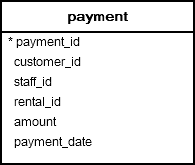PostgreSQL MAX Function
Summary: in this tutorial, you will learn how to use the PostgreSQL MAX() function to get the maximum value of a set of values.
Introduction to PostgreSQL MAX() function
PostgreSQL MAX() function is an aggregate function that returns the maximum value in a set of values.
The MAX() function can be useful in many cases. For example, you can use it to find the employees with the highest salary or to identify the most expensive products.
Here’s the syntax of the MAX function:
MAX(expression);You can use the MAX() function not just in the SELECT clause but also in the WHERE and HAVING clauses.
PostgreSQL MAX() function examples
Let’s take some examples of using the MAX() function. We’ll use the payment table from the sample database.
1) Basic PostgreSQL MAX() function example
The following query uses the MAX() function to find the highest amount paid by customers in the payment table:
SELECT
MAX(amount)
FROM
payment;Output:
max
-------
11.99
(1 row)2) Using the PostgreSQL MAX() function in subquery
The following example uses the MAX() function in a subquery to get the detailed payment information:
SELECT
payment_id,
customer_id,
amount
FROM
payment
WHERE
amount = (
SELECT
MAX (amount)
FROM
payment
);Output:
payment_id | customer_id | amount
------------+-------------+--------
20403 | 362 | 11.99
22650 | 204 | 11.99
23757 | 116 | 11.99
...How it works.
- First, the subquery uses the
MAX()function to return the highest payment. - Second, the outer query retrieves all the payments whose amounts are equal to the highest payment returned from the subquery.
3) Using PostgreSQL MAX() function with the GROUP BY clause
You can combine the MAXfunction with the GROUP BY clause to get the maximum value for each group.
The following example uses the MAX() function with a GROUP BY clause to retrieve the highest payment paid by each customer.
SELECT
customer_id,
MAX (amount)
FROM
payment
GROUP BY
customer_id;Output:
customer_id | max
-------------+-------
184 | 9.99
87 | 10.99
477 | 10.99
273 | 8.994) Using PostgreSQL MAX() function with a HAVING clause
If you use the MAX() function in a HAVING clause, you can apply a filter for a group. For example, the following query uses the MAX() function to select the highest payment made by each customer and includes those that are over 8.99:
SELECT
customer_id,
MAX (amount)
FROM
payment
GROUP BY
customer_id
HAVING
MAX(amount) > 8.99;Output:
customer_id | max
-------------+-------
184 | 9.99
87 | 10.99
477 | 10.99
550 | 10.99
51 | 9.99
...Summary
- Use the PostgreSQL
MAX()function to find the maximum value of a set.
